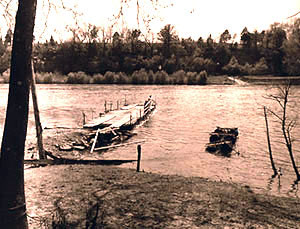
Ferries
Tennessee contains 19,200 miles of streams, including 1,062 miles of navigable waterways. These streams initially served as a major means of transportation that allowed early settlers access to markets and permitted travel between isolated communities. Future urban centers such as Knoxville, Chattanooga, Nashville, and Memphis developed alongside larger rivers. Other communities of various sizes rose and flourished beside smaller streams, only to decline and die as overland transportation became more accessible and reliable. Paradoxically, the same streams that brought settlers to Tennessee and served as frontier highways sometimes became barriers to expansion.
Prior to the later nineteenth century, state and local governments implemented few road-building efforts. During the frontier era, settlers used old animal and Indian trails, fording most streams or building crude rafts to cross larger rivers. As more settlers arrived in the late 1770s and early 1800s, however, the need for more reliable ways to cross rivers became evident. Ferry boats, operated by individuals or corporations, soon appeared at major river crossings. Operators typically used the current to propel the vessel. Passengers paid a fee variously based on the number of persons crossing, the number of livestock, or the number of wheels on vehicles. Some seven hundred to one thousand ferries operated in Tennessee in the nineteenth century.
In isolated areas ferries served as social and commercial sites, and communities developed around the ferry crossing. Frequently the community, often called a landing, derived its name from the ferry owner. For example, the Tennessee River landing and ferry operation of John and Lewis Ross became Ross’s Landing, the forerunner of Chattanooga. The city’s 1916 Market Street Bridge on State Route 8 is adjacent to the site of this 1815 ferry operation.
Beginning around 1880 the Good Roads Movement strongly promoted the construction of bridges and the elimination of ferries. Both the state and individual counties improved road corridors and erected bridges to replace ferry operations. Changing traffic patterns and shifts in transportation corridors rendered many ferry crossings obsolete, and they faded into obscurity. In addition to its other road projects, Tennessee developed an ambitious and unique toll bridge program in the 1920s that replaced seventeen ferries on major rivers. By the mid-twentieth century a ferry crossing, once a symbol of a strategic location on a transportation route, indicated a secondary transportation corridor. Few, if any, traces of many of these ferry operations remain.
By 2000 few ferries operated in Tennessee. In 1997 the Coast Guard licensed two ferry operations in the state, the Saltillo Ferry in Hardin County and the Cumberland City Ferry in Stewart County, but noted that a bridge to serve the Saltillo transportation corridor was under construction.



